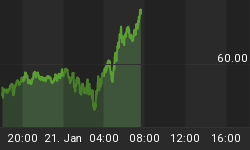With the economy softening and the Federal Reserve unable to provide a positive catalyst in the form of lower rates, the bond market has taken up of the slack producing lower yields. For example, mortgage rates have dropped over the past month enticing homeowners to refinance. It may not clear the glut of homes on the market or get us back to the old days of your house as an ATM machine, but lower rates do help. This appears to be a trend that will continue especially since Washington and the Fed no longer have the political will to expand the deficit.
Technically, this appears to be the correct view especially from a long term perspective. Figure 1 is a weekly chart of the yield on the 30 year Treasury bond (symbol: $TYX.X). The indicator in the lower panel looks for a clustering of negative divergence bars between price (or yield) and an oscillator used to measure that price. Every top in Treasury yields since 1988 has been heralded by a clustering of negative divergence bars. This time is not different, and the 30 plus year bond bull market (i.e., lower yields) continues on.
Figure 1. $TYX.X/ weekly
Figure 2 is another weekly chart of the yield on the 30 year Treasury bond (symbol: $TYX.X). The maroon colored dots are key pivot points, which are areas of support and resistance. Since 2003 to late, 2008, the 4.2% area has provided support, but that level is now resistance and very much in the rear view mirror of the current move. I would classify that area as very significant, and the fact that we are below that area of support suggests the presence of a longstanding trend towards lower Treasury yields.
Figure 2. $TYX.X/ weekly
The last reason to remain bullish on bonds is that no one loves them. It was only 3 short months ago that I made "the call" to go long bonds, and at that time, others were calling higher Treasury yields the sure bet of the decade. Wrong! Since early April, long term Treasury bonds have risen some 12% while equities have fallen 12%. Despite this out performance, bonds still get no respect as we can see by this headline taken from MarketWatch last week: "Bond rally reflects gloom - but don't bet on it lasting".
In summary, I believe the dynamics are in place for a secular run in bonds.















